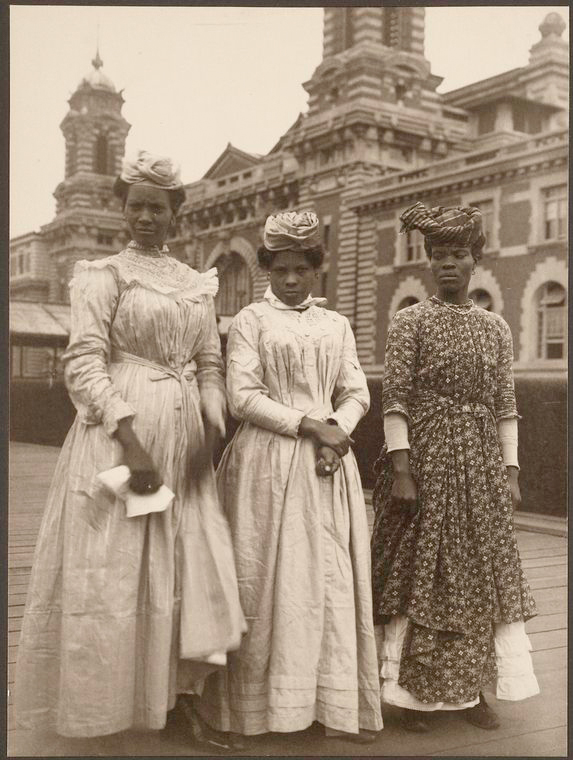Twelve-million immigrants came to the United States through Ellis Island in Upper New York Bay from 1892-1954. At its peak, immigration officials reviewed about 5,000 immigrants per day, two-thirds of whom came from eastern, southern, and central Europe. According to the Statue of Liberty Ellis Island Foundation, the all-time daily high was April 17, 1907 when 11,747 immigrants were processed.
Numerous photographers documented arrivals at Ellis Island, and many of these photographs are available through the New York Public Library Digital Archives. These photographers captured the atmosphere of the immigration center as well as those arriving, many of whom wore the traditional dress of their home countries. Below are some of those images.
William Williams, the original collector of these images, was the federal commissioner of immigration for the Port of New York, from 1902 to 1905 and again, from 1909 to 1914.

Immigrant Station, Ellis Island, with ferry docked at adjacent pier.
Date: 1902-1913
Collector: William Williams
Photographer: Edwin Levick

View of the Immigration Station, Ellis Island (front side).
Date: 1902-1913
Collector: William Williams
Photographer: Edwin Levick

Immigrants seated on long benches, Main Hall, U.S. Immigration Station.
Date: 1902-1913
Collector: William Williams

The pens at Ellis Island, Registry Room (or Great Hall). These people have passed the first mental inspection.
Date: 1902-1913
Collector: William Williams
Photographer: Edwin Levick

Immigrants being registered at one end of the Main Hall, U. S. Immigration Station.
Date: 1902-1910
Collector: William Williams
Photographer: Edwin Levick

Large dining hall, empty except for about ten members of the dining hall staff. The place settings consist of a worn porcelain-enameled plate, a fork and knife.
Date: 1902-1913
Collector: William Williams
Photographer: Edwin Levick

Uncle Sam, host. Immigrants being served a free meal at Ellis Island.
Date: 1902-1913
Collector: William Williams
Photographer: Edwin Levick

Ready for travel and going north, south and west. Immigrants with baggage lined up at teller’s windows marked money exchange.
Date: 1902-1913
Collector: William Williams
Photographer: Edwin Levick

Three women from Guadeloupe.
Collector: William Williams
Photographer: Augustus F. Sherman

Slovak woman and children.
Collector: William Williams
Photographer: Augustus F. Sherman

German stowaway.
Date: 1911
Collector: William Williams
Photographer: Augustus F. Sherman

Dutch woman.
Collector: William Williams
Photographer: Augustus F. Sherman

Group photograph captioned ‘Hungarian Gypsies all of whom were deported’ in The New York Times, Sunday Feb. 12, 1905
Date: 1902
Collector: William Williams
Photographer: Augustus F. Sherman

















